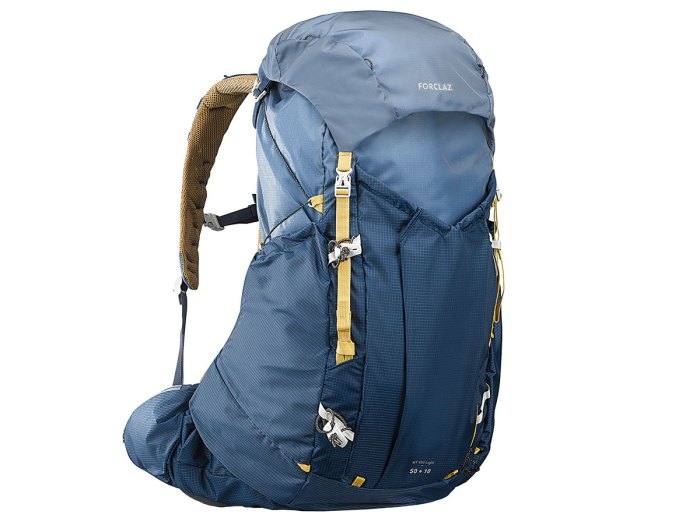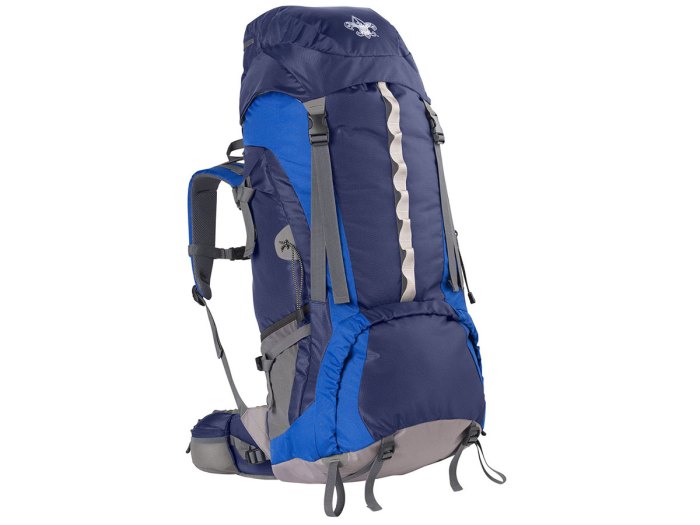Pick the Best Backpack With These Expert Buying Tips

Your backpack and boots are the two pieces of gear you’ll use the most on the trail.
“A pack that fits poorly can make or break your trip,” says Ryan Wichelns, editor-in-chief of Trails Magazine, a lifelong backpacker and former Scout from Stillwater, New York.
“Buy one that fits your body and your gear.”
When shopping for a backpacking pack, the most important thing is to try some packs to see what works, he says. A pack might look cool online but be a bad fit. Everybody is shaped differently. To get the right size, measure your torso length and hip size.

Backpacking experts Ryan Wichelns and Jenn Cadorette.
THE RIGHT FIT
An expert at your local outdoor shop can help you find the best backpack. Some outdoor shops also sell used packs. If you can find one in good shape that fits, a used pack can be a great way to save a few bucks.
Put some weight in a pack and walk around the store for a few minutes. You’ll start to notice what fits your back, shoulders and hips best. Many backpacks have adjustable torso length. That is great for people who are still growing.
The weight of a loaded pack should rest on your hips, not pull on your shoulders. Once your pack is on, watch out. Your hip belt can slide down and compress your butt, back and leg muscles, which keeps them from working right.
“Hip muscles come up higher than you think,” says Jenn Cadorette, a physical therapist and thru-hiker. “Put your hands on your waist and find your hip bones. Your backpack hip belt should stay on those bones.”

PACKING YOUR BACKPACK
How you pack your backpack is as critical as your pack’s fit.
“Pack your heaviest gear close to your back,” Cadorette says. “That will help you stay balanced when you’re hiking.”
Packs are measured in liters. For backpacking, you’ll likely need a pack that’s 35 liters or larger. Buy a pack that’s big enough to carry what you need, but not one that’s too big, or you’ll carry extra pack weight and be tempted to overload.
A versatile pack will have lash points for strapping gear on the outside, though you first want to focus on the inside. For winter backpacking, you’ll need more space for a warmer sleeping bag, extra food and clothing. Less weight is easier and more fun to walk with, but every backpacker must decide what non essential to bring and what to leave at home.
Check Scout Life’s outdoor essential checklists at go.scoutlife.org/essentials
Our favorite backpacks have features that make hiking easier. Hip belt pockets let you grab snacks, your phone and sunscreen without stopping. If your pack doesn’t come with one, you can get one that slides over your belt.
A good pack also lets you drink without taking off the pack, whether it’s a built-in space for a hydration reservoir or easy-to-reach place for a water bottle. The pack should have at least one pocket to organize gear you want to access fast, like water treatment gear, pocketknife and flashlight.
Another nice feature is a lid — or a “brain,” as Wichelns calls it — that can fully unclip so you can easily take your essentials with you into your tent instead of bringing in the whole pack.
Once you’re home, empty and dry your pack. Spot wash the pack with dishwashing soap and a sponge. Maintain your gear, and it’ll last longer.
THE BEST BACKPACKS

Granite Gear Perimeter 50
The Granite Gear Perimeter 50 ($250, granitegear.com) is a simple minimalist pack with loads of great features. The adjustable torso and hip belt fit many people and make the pack one you can grow into. It comes in regular and long torso lengths. The padded, contoured hip belt has big pockets for your gear. Granite Gear’s suspension system is comfy, with articulated, adjustable shoulder straps. The rolltop pack has two stuff pockets on the front and a zippered lid. A bottom flap holds your sleeping pad or tent. A zippered pocket in the flap stores your wet rainfly away from your other gear. Everything else goes in the main compartment. Once your pack is loaded, compression straps cinch it down so you can use this pack comfortably for weekend hikes or bigger projects, like a thru-hike. The Perimeter will last a long time; it’s made from Robic high-tenacity nylon, which is 50% stronger than regular nylon.

Forclaz MT900 UL 50+50L
At 2.9 lbs. and 60 liters, the ultra-versatile Forclaz MT900 UL 50+10L ($189, decathlon.com) is one of the most affordable large-capacity packs. With seven pockets, a hydration reservoir sleeve and clips for trekking poles, it’s ready for any trip. The MT900 lets you access gear through the top or the full side-zip. It’s a great pack for sweaty hikers because a mesh hammock lifts it off your back for airflow, and the shoulder straps and hip belt are highly perforated and covered in mesh for maximum airflow. Side cinching cords take some time to get used to, but ample lashing points and an included rain cover made this pack a top choice. So does the 10-year warranty.

REI Kid’s Tarn
You might find a kid’s pack fits you better than a pack sized for adults. The REI Kid’s Tarn ($119-$165, rei.com) has the quality and features of an adult pack but in sizes made for kids. The 40-liter version, weighing 2 lbs., 10 ounces, is for torsos down to 12 inches. It has enough internal space to suit smaller kids. For bigger kids and longer trips, the 65-liter Tarn, at 3 lbs., 14 oz., has a traditional design with a zippered sleeping bag compartment and top access. The 65-liter pack has dual oversized water bottle pockets, a hydration sleeve and a vented front shove pocket. Its removable lid has backpack straps, so you can leave your big pack behind for short hikes. This pack’s hip belt has a stiffener and thick foam to take the bite out of carrying a heavy load. The harness uses channeled foam for airflow to keep you from getting too sweaty.

Kelty Asher 55
The Kelty Asher 55 ($139, kelty.com), at 3 lbs., 2 oz., has many of the same features as more expensive packs: an adjustable torso, big water bottle pockets, separate sleeping bag access and front-of-the-pack places for strapping overflow gear, but it doesn’t have a removable lid or hip belt pockets. Still, it’s great if you’re on a tight budget. The broad hip belt and airflow back also make this a great first pack.

Nomad RT 50
With a roll-top design, the Nomad RT 50 ($230, alpsmountaineering.com) allows you to compress or expand your pack’s main compartment volume, increasing your overall space to 60 liters or pressing it down to 40 liters. At nearly 5 lbs., the pack is covered in straps and attachment points for fastening gear. This pack comes in 38- and 75-liter versions, too. ALPS Mountaineering offers gear discounts exclusive to Scouts through its Hiker Direct program. For the RT 50 pack, Scouts can get up to 40% off through the program.

BSA Mountaineer 70L backpack
If you have a long gear checklist, the BSA Mountaineer 70L backpack ($120, scoutshop.org) has room to fit all your gear. This 4 lb., 70-liter pack features designated spaces for your sleeping bag, hydration bladder and gear you need to access quickly. You’ll have plenty of storage with its outside mesh pockets, easy-access side pockets and hip belt pockets — plus there’s a place to attach your trekking poles. The pack is designed to feel lighter with its reinforced lumbar support system and adjustable straps.
Is it worth my money to buy the Teton Scout 3400 backpack?
Although the Teton 3400 is a bit heavy and has too many straps for a 3400 c.i. pack it is a good starter for a youth especially at the price. I would not recommend carrying any more than 30 lbs with it, though. The shoulder straps and hip belt are too soft to provide a lot of support. Good for a weekend trek.
I have the Osprey Ace and it is great. My mom got it for me and it has been all over. The shoulder straps hook to back board that you can move up and down depending on how tall you are. It comes with a rain cover too.
I bought a high sierra titan 65 perfect
i can stuff my backpack a lot try buying and rei they’re really good.
Yes, REI is excellent with advice and quality.
I want to buy a High Sierra Titan 65 Internal Frame Backpack, but I am afraid that it will be to big. What should I do?
“Try before you buy” 🙂
are you buying for the looks quality or size?
i say just buy a radom backpack
High Sierra is one of the best packs I had a small one for three years now I have the swerve nothing wrong with the first just a little small. swerve is perfect.
I am getting foxhound 50 pack.
I’m thinking about getting the osprey aether 85 ,is that a good pack? Please respond.
Backpacker magazine rates it as average 5.5 / 10 stars.
Heading to Philmont next year; reducing my pack weight by purchasing a “Go-Lite” 45. Weighs only 2.1# and uses your mattress pad as the back support, really cool; works great. This pack holds the same as my old pack but weighs 4.1# less. costs $99.00. This is a pack for smart scouts; tough-light-inexpensive-roomy.
I hope you’re right knife expert because I’m getting the Teton 4000
Nice dude! let me know how it works for ya.
The Teton pack worked beautifully on a 4 day backpacking trip it balanced the weight out great and it’s super durable . It got dropped and thrown around and it still looks brand new. Great pack! 😀
Glad to hear it!
I have hiked over 75 Northern Idaho miles with this pack. I bought it at a outdoor store for $70. Most stores don’t sell their products at retail price because the retail price is always too expensive.
Go to amazon and look at the reviews… and at the price. I have hiked over 75 miles with this pack and know what i am talking about.
The two comments above were directed at a offensive comment that Father Time made that, thankfully, BL removed.
by the way Father time, my knowledge is NOT confined to knives!